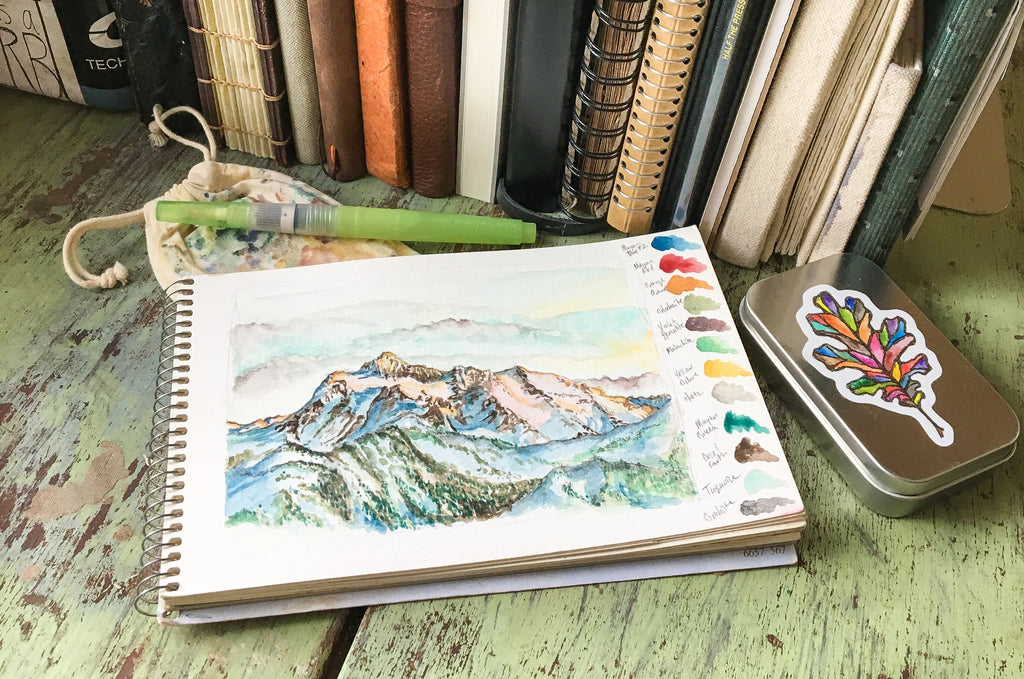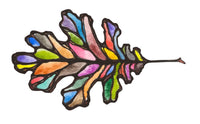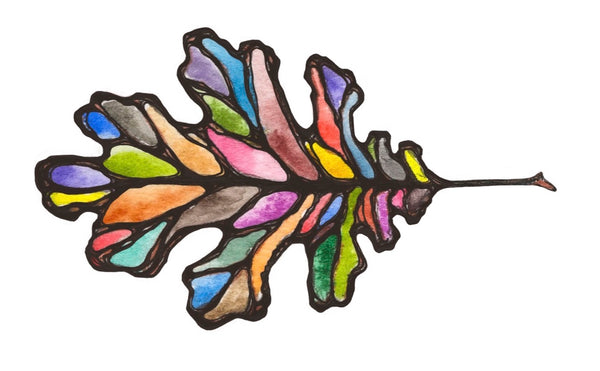
How To Start A Daily Sketchbook Habit
Starting a daily sketchbook practice is one of the very best things you can do for your art and your creativity. A sketchbook is a place for your ideas to percolate and your skills to develop. It is a place where you can safely make mistakes and try new things. It can be just for you or something you share and use to connect to other people. The purpose of keeping a sketchbook is to learn in a no-pressure environment.

A sketchbook I carried for casual experiments. This painting of Mt. Shuksan in Washington was done to experiment with a new palette I assembled. Later, it was carried to Nepal, and includes a sketch of the Himalayas.
I have stacks of sketchbooks from over the years, each filled with colorful memories. Some are big, some are small enough to fit in the back pocket of my jeans - or even smaller. Some are full of paintings and notes and are well-worn, covered in stickers and dirt. Others are half-empty and still way too pretty, beckoning to be picked up again. I’ve realized that much of the fun (and breakthroughs!) are in this playful, experimental approach.
The real key is to develop a daily sketchbook practice. Let working in your sketchbook become part of your routine, a cherished ritual you look forward to. You will see your skills improve, and your creativity will blossom as you test and push your own creative boundaries. As a result, you will develop your own artistic style, create a sort of visual diary, improve your observational skills, and spend some quality time with yourself away from all the noise and distractions that can be so ensnaring.
Allowing a fluidity both with your supplies and sketchbook selection will encourage experimentation and creativity.

A painting I did of a famous Van Gogh painting. It helped me change up my brush strokes and loosen up with details.
How To Start A Daily Sketchbook Practice
Where to begin? Your starting point is your paintbox, your brushes, and the blank page.
The magic is that since this practice is for you, you get to set your own parameters. Here are some suggestions to get you going. Choose which ones speak to you and discard the rest. Paradoxically, creativity does well with some direction and limitation - they are actually a wonderful catalyst!

A bouquet of some of my favorite brushes, standing at the ready by a window that affords beautiful light to paint by. If you are just beginning, I would recommend starting with a single round brush, size 6 or 8. Da Vinci brushes are my favorite and we stock them in our shop here.
-
Make art everyday. Just do something. And do it daily. Showing up every day will probably feel uncomfortable at first, but the routine and progress will soon reward you.
-
Set a time limit. Five minutes, fifteen minutes, an hour. Whatever gets you excited. Whatever you think you can actually pull off. Sit down and set a timer if that helps quiet you into staying put. Set your phone alarm or the egg timer or an hourglass if you have one handy.
-
Choose a place. Maybe keep your sketchbook tucked in next to the cookbooks and settle down at the kitchen table for ten minutes a day. Maybe take it to the coffee shop with you. Or keep your sketchbook and art supplies next to the phone (or near where you tend to talk on your cell phone). Some of my favorite doodles were done while I was talking on the phone. It is distracting and can therefore allow you to be more free, less inhibited. Or you can go outside. Rain or shine, put on what you need to go sit, observe, and sketch for ten or fifteen minutes. That might not sound like enough time, but it will get you out there and you will see something you wouldn’t have otherwise seen, create something you wouldn’t otherwise have created. It is about the experience and the practice more than the result.
-
Prioritize your pastimes. We all waste a lot of time each day doing things that don’t really rank on the self-actualization meter. How much time do you spend texting, facebooking, watching netflix, or running extra errands? Swap out ten minutes of something unnecessary to make time for your daily sketchbook practice. It is a real challenge to quiet the chaos of daily life. When considering how to spend your time, thinking about what you will remember in the long term can help put things into perspective. Think about what will make you feel best about yourself. (If you need a few strategies to help open a small window of time, I wrote a blog post all about how to steal back your time here.)
- Create a ritual. This can reinforce your new habit and enhance your experience of it. This is because when you ritualize something you make it personal - it is customized specifically to bring you joy. Maybe you will sit by the window, light a scented candle, pour a glass of wine, and sketch while listening to an Edith Piaf record. Perhaps you will assemble your sketch kit and a little snack into a cloth satchel that you will carry with you to the park or your backyard. Pick a few of your favorite things and surround your new habit with them.
Where To Start A Daily Sketchbook Practice
Well, in a sketchbook to start! But the paper options are nearly infinite. It helps to see ‘sketchbook’ is a really loose term - anything works, really, just as long as you get scribbling! Choose your surface, choose your tools, and get to it! It is important to avoid getting bogged down with selecting your materials when you are just beginning your habit - and to avoid selecting too many. Choose a sketchbook, a few drawing tools, and a set of colors, and start there. Your preferences will develop and your creative materials will evolve with your skills and tastes. You will never be wrong to experiment and be playful.

A stack of some sketchbooks I have used over the years - different sizes, orientations, and paper types. Switching up your sketchbook is a wonderful way to mix things up and stretch your creative muscles.
1. Pick Your Paper
Then pick some more if you want. You can go the classic route and pick out a sketchbook. Head to your local art store or book shop, or peruse the different Etsy shops. There are so many different options for sketchbooks. All different sizes and types. Large hard-backed books, small leather-bound with hand-stitched binding. Different pictures on the cover, different papers on the inside: creamy ivory or bright white, deckled edge, spiral bound, perforated pages, watercolor paper or sketch– even graph paper is an option. Some of these even have tinted paper, like grey, beige, or kraft paper brown. Pick something that makes you feel excited. If you don't end up liking it you can choose something different next time. If choosing a whole pad or book seems too committing, just grab a few sheets of random paper - even a napkin or a piece of the newspaper can suffice. Assemble your random scraps into a manila folder and call it your sketchbook. It’s whatever works for you and keeps you creating. If you'd like to learn a little bit about sketchbook options, you can read my post about them here.

Some of the usual suspect that can be found in my painting area. It has taken me years to slowly collect all of these brushes. If you are just starting out, one brush is plenty! Your supply collection will grown and evolve over time - relish the process and resist the urge to buy too much at once.
2. Select Your Colors
One of the questions we receive most frequently is what palette of colors is best for a beginner. Really, there is no single answer - it depends on your preferences. We designed our Awakening Set specifically for beginners because it contains enough color choices and good mixing options without being too overwhelming. If you prefer to work with all natural earth and ochre pigments, then our Ochre Set is an excellent choice. Another great starting point is our Sketcher's Set, which is designed to tackle any subject and match any hue. If you already have a set of colors lying around the house, then use that! You can also customize your own palette (you can peruse our guide on that here), or pick out a handful of individual colors that pique your interest and begin with those - one color is enough!
3. Find Your Brushes
If you are beginning, I suggest you start out with a single round brush, size 6 or 8, depending on how big your sketchbook is. If you would like a few more, then a size 2 round and a 1/2" wash brush will round out an excellent starting set of brushes. It is important not to get too wrapped up with all of the different supply options when just trying to establish a good painting habit - remember to keep your focus on the process, then try to collect new supplies slowly - I assure you it will be more fun that way! For more about watercolor brush options, see my article on the basics here.
4. Choose Your Accessories
A pencil and any paint is enough to begin. But there are so many other options to explore when you are ready. There are water-soluble graphite pencils so you can turn your drawings into watercolor paintings. There is even graphite clay you can make marks with. Quill pens and vintage fountain pens, mechanical pencils with colored leads, gel pens, artist quality crayons, acrylic inks, and watercolor markers. Choose what you are excited to use. Don’t be afraid to try new things. Rummage through your desk drawers or head to your local art supply shop - do not be too intimidated to do this! People who work in art supply shops love art supplies and love to talk about art supplies. Ask questions. More often than not you can sample just about anything.

Supplies I have selected that make me feel inspired and spark creativity. You do not need to pack this many - this was a kit I packed for a trip with a supply selection that evolved over years. Your supply array will look different and grow to be customized to your preferences.
5. Create Your Kit
This can be a place for your supplies to adorn if you plan to paint at home, or a way to carry them around if you plan to paint out and about. It helps to give new things an away place – where they can be easily accessed and neatly stowed until their next use. I relish choosing accoutrements for my daily sketchbook practice. I just found an antique test tube holder to hold all of my watercolor brushes on my desk. I have an old metal fishing box that holds all of the art supplies I travel with. It can help to have your supplies’ home be both visible and visually appealing. It will remind you of your daily sketchbook practice, and make it more enticing.

These are a few of the art supplies that always travel with me: Tombow Mono Zero mechanical eraser, sprayer for my watercolors, Palomino Blackwing pencil, my hand-carved watercolor paintbrush, some colorful washi tape.
What To Paint In Your Daily Sketchbook Practice
So, you have committed to a daily sketchbook practice. You have a plan of action and the supplies. You are inspired and excited. What are you going to fill your sketchbook with? Do whatever you want, but just don’t let the blank page intimidate you! Here are some ideas to get you started:
1. Personalize It
My favorite way to break in a new sketchbook is to make it my own right away. I add stickers to the cover, put my name on the inside, and toss it into my bag to get those first few scratches and dents. You can get as creative with this as you like. Embellish your inscription, scrawl a threat to anyone you might make off with your work, add a note of congratulations in the back.

I had a lot of fun putting my name in the beginning of this sketchbook. It's on the groovy side, but it was such a fun experiment, which is the point!
2. The Same Damn Thing
Over and over again. If you want. Ever repeated the same word so many times that it completely lost its meaning and just became an abstract sound? You can do that with visuals too, but it’s just a little different - and much more fun. For example: in art school I was given a picture of a human skull and told to replicate it. I spent hours drawing that skull. Then the picture was taken away and I was told to draw the skull again. After I got over my shock and got to drawing, I realized that I now had a reasonably realistic skull “in my fingers”, so to speak. I was hooked, drawing that skull again and again. I was able to take stylistic liberties in my renderings, which gave me great joy, satisfaction, and a great confidence boost. It is a wonderful exercise that is repeatable with anything. Choose a subject that interests you - a bird’s nest maybe, or an acorn, a pair of shoes, or a tube of toothpaste even. Draw it from life, in great detail. Then again, with or without your reference. Turn the object another way and draw it from a different point of view. Become a student of that object. Get it in your fingers. Then fill your entire sketchbook with it.
3. The Same Damn Thing, Version 2
In this version, the object changes, but the place is the same. Imagine a year of painting sunsets. What appears at first to be nuanced differences will over time evolve to be stunning and faceted details with which you are intimately acquainted. The same thing can be done with portraits - of yourself, your pet, the birds outside your window. The sky is the limit - both literally and figuratively.
4. Draw From Life
Inspiration is everywhere, all around you. Draw your hand, the view from the kitchen table, an autumn leaf. Anything can become a subject. The real fun of drawing from life is that your subject is dynamic, and as a result you become more connected to what is around you. The connection is the real treasure in working from observation.
5. Post Cards
Writing letters is such a great way to keep in touch, and since you have to go to the extra trouble of hand writing your thoughts, it is all the more meaningful. I am often strapped for time, and simply can’t get around to a long-winded letter. Post cards are more my speed. And it affords you the chance to spend more time on a picture to adorn just a short note. The added beauty of the post card is that it can be a scrap of paper– just as long as it has an address and stamp! You also can buy pads of blank postcards printed on watercolor paper. Imagine a year of illustrated postcards!
6. Go Abstract
The point is to be making marks. It usually leads somewhere unexpected and charming. Scribble a great tangle of lines and then color in the spaces that are created. Fill your page with all sizes of circles. Practice your signature. Make dots or parallel lines in different colors. There is beauty in repetition, and there is art in it as well.
Parting Thoughts On Beginning A Sketchbook Habit
When beginning your daily sketchbook practice, set yourself up for success. Determine why you want to start a sketchbook and try to clarify what it is you hope to get out of it. Knowing your goals will help you keep going.

Make sure your supplies, the space in which you paint, and the subject you depict bring you joy, and try to focus on the process. Your skills will develop with time.
Your daily sketchbook practice is just for you. No pressure. A safe zone. Set progress goals if you like, but don’t compare yourself to others. Everyone is a beginner at first. We are often our own worst critics. Personal criticism has its own useful place, but it is often allowed a tyrannical rule over us. Give yourself space to make mistakes, allow yourself to feel foolish. You'll make better art because of it!
Wishing you color and inspiration for you and your new sketchbook!




